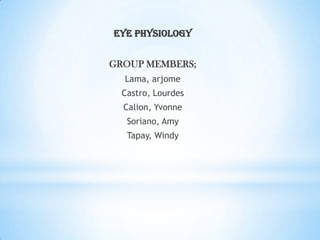Vision anatomy 1
- 1. EYE PHYSIOLOGYGROUP MEMBERS; Lama, arjomeCastro, LourdesCalion, YvonneSoriano, AmyTapay, Windy
- 2. VISION
- 3. Basic Anatomythe EyE isâĶ- very complex organ - approximately 1 inch (2.54 cm) wide -1 inch deep and 0.9 inches (2.3 cm) tall.
- 4. Three different layers1. external layer -formed by the sclera and cornea2. intermediate layer -divided into two parts: anterior (iris and ciliarybody) and posterior (choroid) 3. internal layer/sensory part of the eye-the retina
- 5. Three chambers of fluid:1. Anterior chamber -(between cornea and iris)2. Posterior chamber-(between iris, zonule fibers and lens) 3. Vitreous chamber-(between the lens and the retina). The first two chambers are filled with aqueous humor whereas the vitreous chamber is filled with a more viscous fluid, the vitreous humor.
- 6. Aqueous HumourThe aqueous humour is a jelly-like substance located in the anterior chamber of the eye.ChoroidThe choroid layer is located behind the retina and absorbs unused radiation.CiliaryMuscleThe ciliary muscle is a ring-shaped muscle attached to the iris. It is important because contraction and relaxation of the ciliary muscle controls the shape of the lens.ZonulesThe zonules (or "zonulefibers") attach the lens to the ciliary muscles.Different parts of the eye
- 7. Cornea-a strong clear bulge located at the front of the eye.-has a radius of approximately 8mm.-contributes to the image-forming process by refracting light entering the eye.FoveaThe fovea is a small depression (approx. 1.5 mm in diameter) in the retina.This is the part of the retina in which high-resolution vision of fine detail is possible.HyaloidThe hyaloidcanal divides the aqueous humour from the vitreous humour.Different parts of the eye
- 8. Optic Nerve-second cranial nerve and is responsible for vision.Each nerve contains approx. one million fibres transmitting information from the rod and cone cells of the retina.Lens-a flexible unit that consists of layers of tissue enclosed in a tough capsule.Papilla-"blind spotâScleraThe sclera is a tough white sheath around the outside of the eye-ball.-"white of the eye".Different parts of the eye
- 9. Pupil-the aperture through which light the images we "see" and "perceive" - enters the eye. -formed by irisRetina-The retina contains photosensitive elements (called rods and cones) that convert the light they detect into nerve impulses that are then sent onto the brain along the optic nerve. Iris-the coloured part of the eye.-function is to adjust the size of the pupil to regulate the amount of light admitted into the eye.Vitreous HumourDifferent parts of the eye
- 11. Extrinsic Muscle
- 14. ciliarymuscle












